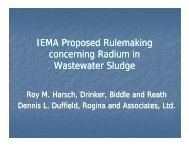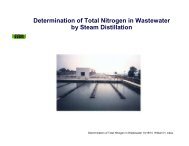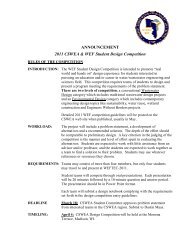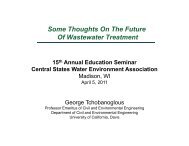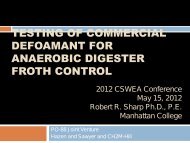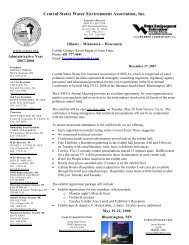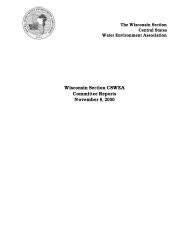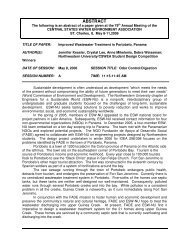NPDES Permits, Compliance and SSOs - Central States Water ...
NPDES Permits, Compliance and SSOs - Central States Water ...
NPDES Permits, Compliance and SSOs - Central States Water ...
Create successful ePaper yourself
Turn your PDF publications into a flip-book with our unique Google optimized e-Paper software.
Regulations/Policies Affecting <strong>SSOs</strong>1. Subtitle C: part 306.304 & 306.3052. 40 CFR 133: Definition of SecondaryTreatment3. 40 CFR 122.41(e): Proper Operation &Maintenance4. USEPA’s s Activitiesa. SSO Task Forceb. Wet Weather Flow Policy of 2002c. Present FR Request for Information2
Proper Operation & MaintenanceRequirements• Treatment Systems• Collection Systems5
USEPA’s s Wet Weather Flow Policyof 2002 prioritized USEPA’s s (<strong>and</strong>states) workload for permit <strong>and</strong>compliance activities. Dischargesfrom CAFOs, stormwaterrequirements for construction siteactivities <strong>and</strong> industrial sites, CSOdischarges <strong>and</strong> LTCP <strong>and</strong> <strong>SSOs</strong>.6
Current <strong>Compliance</strong> Activities2008 – 22 VNs2009 – 71 VNs2010 – 28 VNssent due to <strong>SSOs</strong>7
VN Actions• Immediate <strong>Compliance</strong>• Possible Cease <strong>and</strong> Desist Order ifDefinitely correctable• Possible <strong>Compliance</strong> CommitmentAgreementa. Previous sewer rehabilitation workb. Financial documentation8
Conditions in <strong>NPDES</strong> <strong>Permits</strong>1. I/I Study Requirements• I/I Special Condition General• I/I Special Condition Detailing Efforts <strong>and</strong> EvaluationProcess2. Overflow Prohibition• Prohibits Specific Chronic Overflow Points <strong>and</strong> RequiresReporting• St<strong>and</strong>ard Condition 12(e) Requires Reporting of AnyOverflow9
Previous <strong>Permits</strong> Conditions3. CMOM – Capacity, Management, Operation<strong>and</strong> Maintenance• Requires Development <strong>and</strong> Implementation of aCapacity Management, Operations <strong>and</strong> ManagementPlan4.Authorized Discharges from Excess FlowTreatment Facilities With Effluent Limitations ofBlended or Non-Blended Flows10
The CMOM plan shall include the followingelements (as a minimum):a. Measure <strong>and</strong> Activities:a.1. A complete map of the collection system;2. Schedules, checklists, <strong>and</strong> mechanisms to ensurethat preventative maintenance is performed onequipment;3. An assessment of the capacity of the collection <strong>and</strong>treatment system at critical junctions <strong>and</strong>immediately upstream of locations where overflows<strong>and</strong> backups occur or are likely to occur; <strong>and</strong>4. Identification <strong>and</strong> prioritization of structuraldeficiencies in the system.11
. Design <strong>and</strong> Performance Provisions:b.c.1. Monitor the effectiveness of CMOM;2. Upgrade the elements of the CMOM plan asnecessary; <strong>and</strong>,3. Maintain a summary of CMOM activities.4. Upgrade collection system as necessary.c. Overflow Response Plan:d.e.1. Know where overflows <strong>and</strong> backups occur; <strong>and</strong>,2. Respond to each overflow or backup to determineadditional actions such as clean up.d. System Evaluation Plan.e. Reporting <strong>and</strong> Monitoring Requirements.12
Other Requirements Considered• Event Report• Monthly <strong>and</strong> Annual Summaries• Notification of Local Health Departments<strong>and</strong>/or General Public13
History• 1970s – 1980s USEPA <strong>and</strong> IEPA AwardedGrant Money for Excess Flow Facilities– Required I/I Analysis, removal of cost-effective I/I, treatment of remaining flows.• Define Discharge Requirements for ExcessFlow Requirements– 35 IAC306..305 <strong>and</strong> 40 CFR 133• 1995 USEPA Charters Urban Wet WeatherFlow Federal Advisory Committee (FAC)14
History (cont.)• October 20, 1999 FAC CompletedFramework to Address <strong>SSOs</strong>• Notice of Proposed Rulemaking Was NeverFormally Released• November 7, 2003 EPA Seeks Commentson Draft Policy15
Thursday, December 22, 2005Proposed Rules• Result of National Resource DefenseCouncil (NRDC)• National Association of Clean <strong>Water</strong>Agencies (NACWA) Joint Proposal• Clarification That Bypass Provisions WouldApply to Wet Weather Diversions atPOTWs16
EPA Anticipates Elimination ofPeak Wet Weather Diversions1. Storage Enhancement2. Treatment Capacity Increases3. Source Reduction17
Applicability of the BypassRegulation to Blending(40 CFR 122.41(m))• Interprets Wet Weather flow diversions aroundsecondary treatment <strong>and</strong> recombined with treatedeffluent• Interprets “no feasible alternatives” in 40 CFR122.41(m)(4)(i)(B)• Does not apply to:– Discharges prior to the headworks (off site diversions)– Dry Weather Diversions– Diversions around primary or tertiary treatment– Diverted flow that is not recombined with flow fromsecondary treatment18
Applicability of the BypassRegulation to Blending(40 CFR 122.41(m))• Promotes measures to provide treatmentat peak wet weather flow• Promotes reporting <strong>and</strong> public notificationof wet weather diversion• Ensures full utilization of secondarytreatment capacity at Design MaximumFlow19
Applicability of the BypassRegulation to Blending(40 CFR 122.41(m))• Reduces infiltration <strong>and</strong> inflow (I/I)• Maximizes collection system storage• Provides for off-line storage• Provides for sufficient secondarytreatment20
No Feasible Alternatives• Analysis Provided for Every RenewalApplication or New Bypass Facility– Documents Design Maximum Treatment Capacity<strong>and</strong> Assesses Treatment Capacity Increases– Estimates frequency, duration <strong>and</strong> volume ofdiversions <strong>and</strong> evaluates reduction alternatives– Estimates future diversions <strong>and</strong> evaluatesalternatives– Assesses existing storage availability or expansion21
No Feasible Alternatives• Assesses reduction alternatives• Evaluates technology augmentation• Evaluates I/I reduction• Evaluates reductions through CMOMenhancements• Evaluates funding capabilities for alternatives• Monitoring protocol for recombined flow• Projects effluent improvements related toutility improvements22
IEPA Requirements• Evaluate the utility analysis <strong>and</strong> requireimplementation of treatment to the greatestpossible wet weather flow accounting the fullrange of economic, environmental, publichealth <strong>and</strong> engineering considerations• Approve or deny wet weather diversionsbased upon feasible <strong>and</strong> affordablealternatives• Permit provisions recognizing approveddiversions <strong>and</strong> conditions such diversions23
IEPA Requirements• Require notice of peak wet weather diversion eventswithin 24 hours of each event <strong>and</strong> the volume of theevent 48 hours after cessation• Require monitoring on a daily basis• Explain in the Fact Sheet calculations of peak flows,reasons allowing peak flows <strong>and</strong> any permit provisions ofpeak flow• Include permit provisions for pretreatment programrevision to account for wet weather flow/divert industrialflows around bypasses• Rigorously review each renewal request for continuedwet weather diversion approval. 24
Draft Guidance on Preparing aUtility Analysis• July 2009• Explains in detail nine elements of ananalysis• Provides nine page checklist25
June 1, 2010 Seeking Input onCurrent Regulatory Framework1. Should EPA propose to clarify its st<strong>and</strong>ard permitconditions for SSO reporting, recordkeeping <strong>and</strong>public notification?2. Should EPA propose to develop a st<strong>and</strong>ard permitcondition with requirements for capacity,management, operations <strong>and</strong> maintenanceprograms based on asset managementprinciples?3. Should EPA propose to require permit coveragefor municipal satellite collection systems?26
June 1, 2010 Seeking Input onCurrent Regulatory Framework4. What is the appropriate role of <strong>NPDES</strong>permits in addressing unauthorized <strong>SSOs</strong>that are caused by exceptionalcircumstances?5. How should EPA address peak flows atPOTW treatment plants?6. What are the costs <strong>and</strong> benefits of CMOMprograms <strong>and</strong> asset management ofsanitary sewers?7. Are there other considerations?7.27
WEB SITESGuide for Evaluating Capacity, ManagementOperation, <strong>and</strong> Maintenance (CMOM) Programs atSanitary Sewer Collection Systemshttp://www.epa.gov/npdes/pubs/cmom_guide_for_collection_systems.pdfSanitary Sewer Overflowshttp://cfpub/epa/gov/npdes/home.cfm?program_id=428
WEB SITESJune 1, 2010 Request for Inputhttp://edocket/access.gpo.gov/2010/2010-13098.htm2009 Utilities Analysishttp://www/epa/gov/npdes/sanitaryseweroverflows2005 Proposed Rulehttp://www/epa/gov/npdes/wetweather/Rick Pinneo @ 217/782-0610rick.pinneo@illinois.gov29



